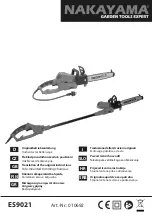
8
ENGLISH
(Original instructions)
u
Re-insert the battery (5).
u
If the charging indicators continues flashing red at a fast
rate, use a different battery to determine if the charging
process works properly.
u
If the replaced battery charges correctly, the original
battery is defective and should be returned to a service
centre for recycling.
u
If the new battery gives the same indication as the original
battery, take the charger to be tested at an authorised
service centre.
Note: It may take as long as 60 minutes to determine that
the battery is defective. If the battery is too hot or too
cold, the LED will alternately blink red, fast and slow, one
flash at each speed and repeat.
Switching on and off
The variable speed on/off switch offers a choice of speeds for
greatly improved cutting rates in various materials.
u
To switch the tool on, squeeze the variable speed on/off
switch (1).
u
To switch the tool off, release the variable speed on/off
switch (1).
Sawing (fig. F)
u
Always hold the tool with both hands.
u
Let the blade run freely for a few seconds before starting
the cut.
u
Apply only a gentle pressure to the tool while performing
the cut.
u
If possible, work with the shoe (6) pressed against the
workpiece. This will improve tool control and reduce tool
vibration, as well as prevent the blade from being dam-
aged.
LED work light
The LED work light (10) is activated automatically when the
trigger is depressed. The LED work light will illuminate when
the trigger is partially depressed, before the unit begins
running.
Hints for optimum use
Sawing wood
u
Clamp the workpiece securely and remove all nails and
metal objects.
u
Holding the tool with both hands, work with the shoe (1)
pressed against the workpiece.
Flush cutting (fig. G)
The compact design of the reciprocating saw motor housing
and pivoting shoe permit close cutting to floors, corners and
other difficult areas.
To maximize flush cutting capabilities:
u
Insert the blade shaft into the blade clamp with the teeth of
the blade facing up.
u
Adjust the angle of the handle on the tool so you are as
close to the work surface as possible.
Sawing metal (fig. H)
Be aware that sawing metal takes much more time than
sawing wood.
u
Use a saw blade suitable for sawing metal. Use a fine-
tooth saw blade for ferrous metals and a coarser saw
blade for non-ferrous metals.
u
When cutting thin sheet metal, clamp a piece of scrap
wood to the back surface of the workpiece and cut through
this sandwich.
u
Spread a film of oil along the intended line of cut.
Pocket cutting in wood (fig. I)
u
Measure and mark the required pocket cut.
u
Fit a saw blade suitable for pocket cutting.
u
Rest the shoe (6) on the workpiece in such a position that
the blade forms an appropriate angle for the pocket cut.
u
Switch on the tool and slowly feed the blade into the
workpiece. Make sure that the shoe (6) remains in contact
with the workpiece at all times.
Cutting branches
Branches up to 25 mm in diameter can be cut with this tool.
Warning!
Do not use the tool while in a tree, on a ladder or
on any other unstable surface. Be aware of where the branch
will fall.
u
Cut downward and away from your body.
u
Make the cut close to the main branch or tree body.
Vertical cutting
The tool allows close cutting to corners and other difficult
areas.
u
Insert the shank of the saw blade into the blade holder
with the teeth of the blade facing upward.
u
Hold the tool with the shoe (6) facing downward so that
you are as close to the work surface as possible.
u
Cut forward and away from your body.
Accessories
The performance of your tool depends on the accessory used.
Black & Decker and Piranha accessories are engineered to
high quality standards and designed to enhance the perform-
ance of your tool. By using these accessories you will get the
very best from your tool.
Summary of Contents for HPL10RS
Page 1: ...HPL10RS ...
Page 2: ...2 A C B D E ...
Page 3: ...3 F I G H J ...
Page 11: ...TYP www 2helpU com 13 11 10 E16236 HPL10RS 5 6 H1 1 2 3 4 7 ...






























